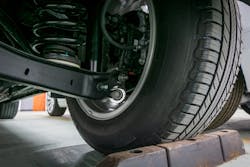Tech Tip: 3 ways to prevent wear and tear on steering and suspension parts
Steering and suspension components on a vehicle can make or break the driving experience, as they’re responsible for ride comfort and directional stability. What’s more, worn, loose, or misadjusted steering and suspension components can negatively impact the life of a vehicle’s tires.
Tire rods, ball joints, and center links are just a few steering and suspension components that require regular inspections, maintenance, and of course, lubrication, to properly maintain and avoid costly repairs.
To prevent the wear-and-tear of these components and avoid repairs, consider these tips to keep steering and suspension parts properly lubricated.
- Metal on metal requires lubrication: Whether it’s tire rods or ball joints, metal on metal should not be ignored but rather be the subject of focused attention when it comes it lubrication. If there’s an intersection with other materials like plastic or rubber, consider a center link. It’s important to choose a lubricant that is safe for multiple surfaces.
- Consider the environment: The environment in which an automotive shop operates can play a big role in which lubricant is used. In general, dry lubes are best in environments that are prone to dust since they won’t attract dirt, although they won’t last as long as a wet lube. Wet lubes can attract gunk and need regular cleaning but provide superior performance in keeping rust and corrosion off equipment.
- Apply with precision: While lubrication is a must, over spray can get messy, wastes product, and requires extra time and effort in clean up. To avoid over spray, apply lubricants with precision. Products such as WD-40 Specialist Gel Lube goes on thick and stays where you spray it, making it ideal for use on vertical surfaces.
Information provided by WD-40.
